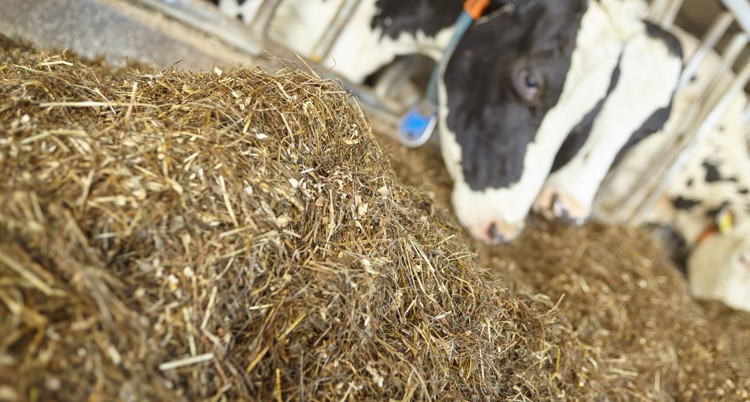Selection: the camouflaged crisis
Nutritionists often spend hours analysing many different ingredients and mixes to develop the correct formulations, while it is known that the wrong management factors can cause more damage. There is an old saying in the dairy industry stating that there are always four rations given to – the one that is formulated, the one that is put into the mixer wagon, the one mixed and finally the one that the cow eats. These days the first three rations is often correct because their formulation is given enough attention, it is at the last hurdle where so many dairies encounter an unmarked obstacle. This obstacle is selection, hidden in the best of camouflage, but can cause as much damage as the strongest of poison.

Selection
Selection is a process whereby a cow separates the TMR (total mixed ration) into its original components and then normally continues only to take in the concentrated feed. This is often undetected because the entire ration is still eaten by the group. The difference lies in the fact that some cows are mainly eating concentrated feed and some others are eating roughage only. Keeping in mind the above and the fact that the dairy cows require special nutritional formulations, it is obvious that the daily variation in the ingested ration cannot have a positive effect on the lactating animal.
Background
A brief background is necessary to understand the negative effect that selection has on the animals. Most of the digestion of dairy cows occurs in the rumen and is done by rumen microbes via fermentation. Different populations of micro-organisms are responsible for the digestion of different nutrient sources. For example fibrolytic bacteria are responsible for the digestion of fibre, in other words for digesting the of roughage sources. Rumen microbial populations and specifically fibrolytic bacteria are pH sensitive. The optimum pH in the rumen is between 5,8 and 6,4. A rumen pH below 5,8 will result in the death of fibre digesting bacteria and the ineffective utilization of roughage. Fermentation produces volatile fatty acids which, in turn, decrease the pH in the rumen. The pH is buffered by saliva that comes from rumination and the absorption of volatile fatty acids. Selection has a negative effect, because it is the amount of fatty acids that are produced that increases as concentrated intake increases and the buffering capacity of the rumen is hampered because of the reduced intake of roughage and effective fibre. With the reduced pH in the rumen, the micro-organisms that consume fibre are damaged, and as mentioned previously, the utilization of roughage is adversely affected. The decrease in rumen pH also leads to asidoses or subclinical acidosis.
Cow signals:
There are several signs to look for when it comes to identifying selection. Cows don’t lie and to look and listen for signs carefully can have great benefits for a dairy farmer.
Manure
One of the first signs is visible in the manure. Manure is evaluated by a score of 1 to 5. When this is applied to manure a 1 means watery manure and a 5 is awarded to firm manure that is similar to horse manure. The ideal evaluation for a healthy cow is a score of 3. A score of 3 is the ideal and it is often referred to as having the consistency of thick yoghurt. Variation in the consistency of the manure within a particular herd or group indicates that selection is taking place, because the variation in the intake of the ration affects the different consistencies of the manure.
Variation in milk production
A second sign is a variation in the milk production of certain animals from day to day. It is often overlooked because the group’s average remains consistent, but if you look at individual cows, the variation is evident. Variation is obviously normal, but within limits. If the variation is more than 10% on a daily basis, there is sufficient reason to investigate the situation. The variation comes from the fact that a cow mostly eats only concentrated food during one day. This causes discomfort due to subclinical acidosis. The following day, the animal holds back and eats the normal amount, and can even give preference to roughage. The reduced intake and reduced energy density in the ration ingested then causes the drop in milk production. This is a vicious circle that can only be remedied by the elimination of selection.
Reduced butterfat
Reduced butterfat is often associated with selection. The main reason for this is simply the reduced intake of roughage when animals are selecting feed intake, as roughage is usually cast aside. A second reason for this is that the higher levels of concentrated feed will lead to an unnecessarily low drop of the pH in the rumen. As indicated earlier on, fibre consuming bacteria are sensitive to a pH below 5,8 it and may lead to the death of the bacteria. The death of the microbial populations inhibits the digestion of fibre, which in turn affects the butterfat negatively. The problem can also not be rectified overnight; microbial populations can take up to 21 days to recover after a single low pH episode. Research has shown that specific fibre digesting bacteria could survive better at a constant lowish pH rather than a higher average pH which dip below a pH of 5.8 three or four times a day, as is the case with selection. This is therefore another reason to eliminate selection.
Solutions
There are fairly simple ways to curb selection. Two key points to look out for is:
- The length of the fibres
- The total dry matter in the ration
Length is definitely the harder of the two to master. If the fibres are too long it makes it easier to select. Animals avoid longer fibres since it is easier to separate them from the TMR and harder to eat. The answer is not simply to mix and to grind the ration to a fine powder. Effective fibre in the ration is one of the most important aspects of dairy nutrition. A good rule of thumb is fibre lengths as long as a match box. Shorter fibres can influence the effectiveness of the fibre and longer fibres can favour selection. This is a management issue that only the farmer can control. It is also something that changes as roughage sources change or even loads or cuts change within the same roughage source. The correct mixer and sharp blades are crucial to manage the process correctly and effectively.
Another point to note is the total moisture in the TMR. A TMR that is too dry facilitates the sifting and separating of the individual components of the ration. If the TMR is too moist it can negatively affect the total dry matter intake of the animals. The ideal dry matter of a ration is usually between 45% and 55%. A good rule of thumb to follow is to squeeze a ball of TMR in your hand. When you open your hand, the ball should crumble and roll off your hand, but it should be wet enough for the meal to still stick to your hand. If the ball does not break open, the TMR is too moist and the moisture should be reduced.
Crib space and frequency
Additional factors that can effect selection may be crib space and the quantity and frequency of feeds. The effect of too little crib space may increase selection by the dominant animals by giving them the benefit to first eat the tastier food, and leave the roughage for the less dominant animals. There must be at least 70 cm per cow crib space, but the ideal situation is a space of 90 cm per cow. Too little feed or animals that must wait for too long periods to feed will worsen the occurrence of selection. It is therefore important to determine the feeding routine and how much feed is needed.
Selection is a problem factor but it can be addressed fairly easily by the farmer should it be important enough to him. As we move closer to summer the prevention of selection becomes an integral part of dairy nutrition. It’s one of the few factors that are completely in the farmers hand and there is no need for it to ever become a problem under the right management.
